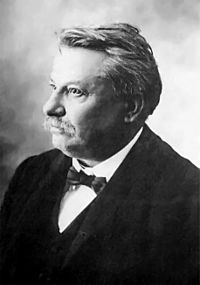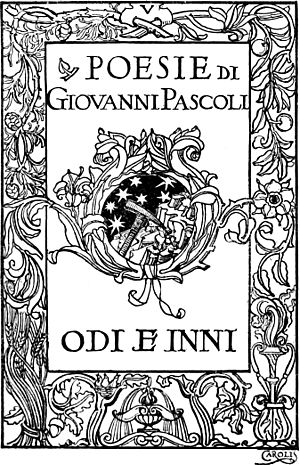Giovanni Pascoli facts for kids
Quick facts for kids
Giovanni Pascoli
|
|
|---|---|
 |
|
| Born | 31 December 1855 San Mauro Pascoli, Italy |
| Died | 6 April 1912 (aged 56) Bologna, Italy |
| Resting place | Castelvecchio di Barga |
| Occupation | Poet, scholar. |
| Literary movement | Symbolism, Decadentism |
| Signature | |
Giovanni Pascoli (born December 31, 1855 – died April 6, 1912) was a famous Italian poet and scholar. He was a very important person in Italian literature during the late 1800s. Many people consider him one of Italy's greatest poets from a style called Decadentism.
Contents
Giovanni Pascoli's Early Life and Education
Giovanni Pascoli was born in a town called San Mauro di Romagna in Italy. His family was quite well-off. He was the fourth of ten children. His father managed a large farm for the Princes Torlonia, where the family lived.
A Tragic Childhood Event
On August 10, 1867, a terrible event happened. Giovanni's father was shot and killed while riding home from the market. The horse he was riding, a black and white mare, carried his body all the way home. The person who committed this crime was never caught.
Giovanni's childhood was very sad. After his father's murder, his mother, a sister, and two brothers also died young. This caused the family to lose their money. The murder of his father especially influenced one of his most famous poems, "La cavalla storna" (The Storna Mare). His first collection of poems, Myricae (published in 1891), shows how much his unhappy childhood affected him.
Moving to Rimini and University Studies
In 1871, Giovanni moved to Rimini with six of his brothers. There, he became friends with Andrea Costa and started joining Socialist protests. This led to another important event: he was briefly put in prison in Bologna. This happened after a protest against the arrest of Giovanni Passannante, who had tried to harm King Humbert I.
Pascoli later studied at the University of Bologna. His teacher and mentor there was the famous poet Giosuè Carducci. In 1882, after graduating, Giovanni started teaching in high schools in Matera and Massa. He wanted to rebuild his family, so he lived with his sisters Ida and Maria. He called their home a "nest."
Working as a Poet and Professor
Giovanni Pascoli started writing for a magazine called Vita nuova. This magazine published his first poems, which were later put together in his book Myricae. In 1894, he moved to Rome to work for the Ministry of Public Instruction. There, he published an early version of his Poemi conviviali. He later lived in Bologna, Florence, and Messina. However, he always felt a strong connection to his simple, country roots.
In 1895, Giovanni and his sister Maria bought a house in Castelvecchio, near Barga, in Tuscany. He used money he won from literary awards to buy it. The political changes and social problems in the early 1900s, which led to World War I and the rise of Fascism in Italy, made Pascoli feel even more worried and sad.
From 1897 to 1903, he taught Latin at the University of Messina and then in Pisa. When his former teacher, Carducci, retired, Pascoli took his place as a professor of Italian literature at the University of Bologna. He was buried in a small chapel next to his house in Castelvecchio, where his beloved sister, Maria, was also laid to rest.
Understanding Giovanni Pascoli's Poetic Style
Giovanni Pascoli did not actively join any specific literary movements of his time. However, his works show ideas common in the late 1800s, especially spiritual and idealistic thoughts. His poetry often combines older, classical traditions he learned from his teacher Giosuè Carducci with newer themes from Decadentism.
Focus on Nature and Simple Things
Pascoli's poems often focus on home life and nature. Even though his time was interested in science and facts (a period called Positivism), Pascoli believed that life was a mystery. He thought that by finding hidden connections in the simple things of nature, people could understand the truth behind what they saw.
A key part of his poetry was focusing on "small things" (piccole cose). Pascoli moved away from the grand, formal language of earlier poets, including his mentor Carducci. Instead, he wrote poetry that was simple and inspired by everyday life and objects. The title of his first collection, Myricae, comes from a Latin word for "humble tamarisks" (small shrubs), showing his focus on simple things.
Later Poems and International Influence
Pascoli's later poems explore similar themes but are more experimental. They also show his deep knowledge of classical antiquity (ancient Greek and Roman times). His work greatly influenced later Italian poets, who used his thoughtful and sometimes sad themes in their own writing. He wrote poems in both Italian and Latin. He also translated English poetry. His many Latin poems won him several international awards.
In 1897, Pascoli explained his poetic ideas in detail. He called it poetica del fanciullino, which means "poetics of the child." He believed that poetry is like the never-ending ability to be amazed by the world, just like a child. He thought poets should see the world with this childlike wonder.
Pascoli's poetry also has interesting similarities with European Symbolism. He often used analogy (comparing things) and synesthesia (mixing senses, like "seeing sounds"). His poems also have a subtle musicality and use words from different languages, local dialects, and even sound-imitating words. This shows he was exploring new ways to use poetic language.
The Nobel Prize-winning poet Seamus Heaney discovered Pascoli's work in 2001. Heaney later translated and adapted Pascoli's poem "L’aquilone" ("The Kite") in 2009. He also translated "L’ultima passeggiata" ("The Last Walk"), which was published after Heaney's death in 2013.
Several books of Pascoli's work have been translated into English. These include Last Voyage: Selected Poems of Giovanni Pascoli (2010), Selected Poems of Giovanni Pascoli (2019), and Last Dream (2019). The book Last Dream won an important award in 2020.
Pascoli was also known for writing essays and for his studies on the famous poet Dante.
Giovanni Pascoli's Published Works
- Myricae (1891)
- Lyra romana (1895)
- Il fanciullino (1897)
- Pensieri sull'arte poetica (1897)
- Epos (1897)
- Poemetti (1897)
- Minerva oscura (1898)
- Intorno alla Minerva oscura (1899)
- Sotto il velame (1900)
- Sul limitare (1900)
- Fior da fiore (1901)
- La mirabile visione (1902)
- Canti di Castelvecchio (1903)
- Primi poemetti (1904)
- Poemi conviviali (1904)
- Odi e inni (1906)
- Canti di Castelvecchio (Final edition, 1906)
- Pensieri e discorsi (1907)
- Canzoni di re Enzio (1909)
- Nuovi poemetti (1909)
- La grande proletaria si è mossa (1911)
- Poemi italici (1911)
- Poesie varie (1912)
- Poemi del Risorgimento (1913)
See also
 In Spanish: Giovanni Pascoli para niños
In Spanish: Giovanni Pascoli para niños


